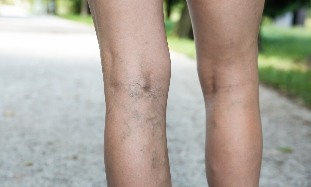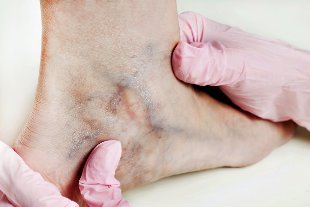Treatments the veins of the lower extremities in men and women differ, however, the frequency of postoperative recurrence in women above in connection with the further influence of hormones (estrogenic influence).

Venous disease of the legs should be treated at the doctor-phlebologist, who addresses precisely this pathology. Various methods of treatment of varicose veins are not radical, because it is not aimed at the elimination of the basic pathogenetic cause – failure of the valve apparatus of vienna. Surgical and conservative treatment delay the progression of the disease on the long lines. The percentage of relapses a high, and reaches from 10 to 50% at 5 years after surgery.
Treatment of varicose veins must be comprehensive. There are three groups of methods of removing varicose veins:
- surgical,
- conservative.
Each type of treatment has its advantages and disadvantages, a certain frequency of recurrence. The choice of method is conditioned, because the phlebologist to achieve the most favorable outcome, it often needs to combine all three methods.
The characteristic symptoms of varicose veins in women
Common manifestations, characteristic for women
Symptoms of varicose disease begins with the advent of these functional disorders such as feeling of heaviness in the legs, swelling of the ankle joints to the end of the working day. On the skin of the feet first, form a vascular asterisks.
The basic symptoms of the disease – the association of varicose dilated subcutaneous veins, appear several years after the onset of the disease.
In the absence of treatment at this stage, occur such symptoms as cramps in the calf muscles, itching skin on the feet.
Symptoms of venous disorders: pigmentation of the skin in the lower third of the lower leg, cyanosis, sclerotic changes of the subcutaneous tissue, eczema, on the background of which is formed by a trophic ulcer.
The characteristic symptoms of varicose veins just for women
- Painful symptoms appear cyclic, that are more intense than the monthly salary, which is caused by changing levels of sex hormones;
- during pregnancy symptoms varicose veins after birth may disappear;
- in the second half of the menstrual cycle due to the action of progesterone the diameter of the varicose veins increases, so the symptoms are swelling and heaviness in the legs expressed more;
- symptoms of varicose veins other during hormonal therapy.
Now let's talk about the methods and therapy.
The best methods of treatment
Radiofrequency ablation and laser coagulation
Radiofrequency ablation of veins
The method is based on the introduction of the under ULTRASOUND control special disposable catheter in the lumen of the dilated veins.

The catheter is equipped with a special electrode, the working part, which by the action of the radio-frequency radiation heats up to 120 degrees. Promotion of the catheter during the vein leads to the bonding of the vascular wall. The affected vein off from the circulatory system of the lower extremities.
Venous laser coagulation
The technique of the operation consists of the injection site of the affected vein and the introduction of its height under ultrasound guidance the laser optical waveguide. By the action of laser radiation occurs coagulation of the proteins of the vascular wall, thereby to vienna to subside and after some time it is overgrown with connective tissue.
Radiofrequency ablation and vein laser smoothing are relatively new methods of treatment of varicose veins on the legs. Despite the differences in the technique of execution, have common characteristics.
The advantages and disadvantages of radiofrequency ablation and vein laser smoothing
Advantages:
- Do not require hospitalization;
- Constancy of performance (from 30 min to 1 hour);
- Painless;
- Bloodless;
- Is performed under local anesthesia;
- The lack of postoperative scar (required for women cosmetic effect);
- A short time of rehabilitation.
Disadvantages:
- High price;
- The frequency of recurrence to 10%;
- The inability to perform in some of the anatomical features of the veins (severe tortuosity of the blood vessels).
Radiofrequency ablation and vein laser smoothing choose women who want to treat varicose veins in an outpatient setting with minimal restriction of physical activity in the postoperative period and with the imposition of aesthetic types of feet.
Fleboskleroterapija
In the lumen of the affected segment of the vein introduced a special product which has a specific action on the vascular wall. Sclerosing agent may be used in liquid form or in the form of a foam. Need to give preference to foam sclerotherapy due to the larger area of contact of the substance with the wall of the vein.
The advantages and disadvantages of Fleboskleroterapija:
- The lack of post-operative scar;
- Is performed on an outpatient basis;
- The operation is performed without anesthesia;
- Handling is virtually painless (a mild burning sensation at the site of injection);
- It is possible the persistent pigmentation of the skin at the site of injection (within 2 years);
- In rare cases of post-operative inflammation of the veins (phlebitis);
- Swelling and redness of the tissues after a period of 2 days after the treatment;
- An allergic reaction in the individual intolerance of the product;
- In 20% of cases appear vascular asterisks on legs (telangiectasia);
- The frequency of recurrence by up to 50%.
Recurrence of varicose veins after sclerotherapy depends on the lumen of the affected vessel - the greater the height, the higher the risk of recanalization in it. This therapy selected when the treatment of recurrent varicose veins after surgical phlebectomy.
Surgical phlebectomy
Surgery is the more radical method of removing varicose disease. Principles of surgical treatment consist in the removal of a defective discharge of blood from the deep to the superficial veins on the legs and removal of dilated blood vessels. The phase of the combined phlebectomy:

- Intersection and ligation of the mouth of the large subcutaneous veins (incision in the groin) or small subcutaneous veins (incision in the popliteal cranial);
- The removal of strains, varicose veins. Performed using a special metal probe, which draws from vienna in the incision of the skin.
Advantages:
- Radical;
- The possibility of performing the operation at any stage of the disease.
Disadvantages:
- Hospitalization is 5 to 7 days;
- Scar on the foot;
- Anesthesia spinal or joint;
- Injury to surrounding tissue during extraction of the vein;
- Possible complications: bleeding, injection of the wound;
- The frequency of recurrence of up to 20%.
Treatment of functional the fact that the best at a certain type of lesion, when there is a varicose deformation of large or small subcutaneous veins on the significant period of time. And also, when are the symptoms of venous disorders of the soft tissues and symptoms of decompensation of venous insufficiency.
Miniflebjektomija
Miniflebjektomija – own option is a surgical procedure in which it is possible to treat varicose veins on the legs in the initial stages. More often it is used in the presence of the individual varicose enlarged nodes on the legs. Performed puncture of the skin over the morbid education and with the help of the hook drawn out and cuts through vienna. The operation does not require general anesthesia, and the overlay of skin stitches.
Conservative therapy
Start to treat varicose vein disease of the legs, it is necessary to the application of drugs and compression therapy. Designation of of medication increases the the circulation of blood and to wear medical compression stockings – are the main conditions that determine the outcome of any surgery on the veins of the lower extremities.
Medical therapy
Medication to stop the symptoms of venous insufficiency, are used as preoperative preparation and postoperative rehabilitation.
Treat special drugs for varicose veins on the legs, it is necessary a longer period of time in a continuous mode, either in the form of repeated courses.
Compression therapy
Elastic compression of the legs – the main methods of treatment in cases where surgical intervention is contraindicated. As the compression means can be used elastic bandages and special health care knit goods: stockings, socks, tights. Medical products are characterized by high strength, a long time retain the original level of compression, comfortable when wearing, what's important to women.

There are 4 classes of elastic knitted fabrics depending on the degree of compression. Recommended to treat the varicose veins with the use of products of 2 class in the absence of disease progression for up to 6 months and with further use during physical exertion or during prolonged stay on their feet. If there are signs of lesion of the valves of the deep veins or expressed symptoms of disorders of the lymphatic flow, these are the jerseys 3 classes up to stop the progression of varicose veins.
The therapeutic effect of compression of knitted fabrics is caused by:
- decreasing the volume of the vein, which leads to less leakage of blood into the varicose blood vessels;
- increase absorption of tissue fluid in the blood stream, which makes symptoms swelling and symptoms of heavy legs will disappear;
- better fluidity of the blood, which prevents the formation of blood clots.




































